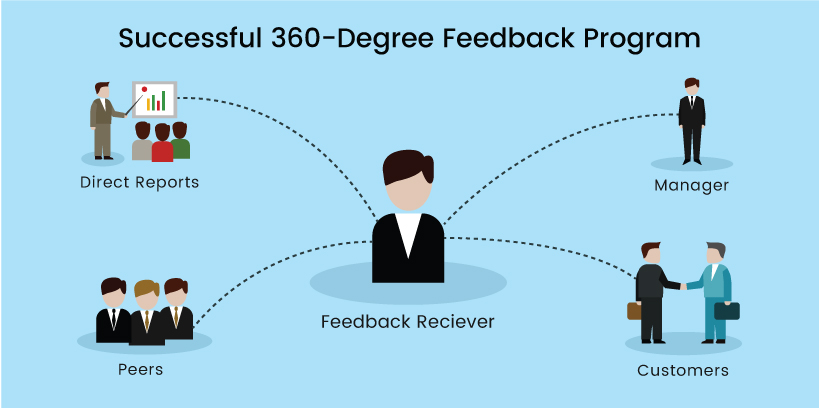In today’s dynamic workplaces, feedback plays a pivotal role in fostering growth and development among employees. Harnessing the power of comprehensive feedback mechanisms is key to unlocking individual potential and driving organizational success. In this article, we delve into the concept of 360-degree feedback, exploring its nuances, advantages, and potential drawbacks.
Exploring 360-Degree Feedback: A Comprehensive Overview
Defining 360-Degree Feedback
360-degree feedback, often referred to as multi-rater assessment, is a feedback system designed to gather anonymous insights about an individual from various stakeholders within and outside the organization. These stakeholders typically include supervisors, peers, direct reports, and other collaborators, providing a holistic perspective from all angles – hence the term “360 degrees.”
The Benefits of 360-Degree Feedback
Enhanced Self-Awareness and Personal Growth
One of the primary advantages of a well-implemented 360-degree feedback system is its ability to offer individuals a comprehensive view of how they are perceived by others. By comparing self-perceptions with external feedback, individuals gain valuable insights into their strengths, weaknesses, beliefs, and motivations. This heightened self-awareness empowers individuals to adapt their behaviors, identify areas for improvement, and pursue targeted development opportunities, ultimately enhancing their effectiveness in their current roles and future career pursuits.
Credibility Through Diverse Perspectives
360-degree feedback draws on input from a diverse range of sources, lending it credibility and objectivity. Unlike traditional top-down feedback models, which rely solely on managerial assessments, multi-rater feedback incorporates insights from multiple stakeholders. This diversity of perspectives not only enriches the feedback but also enhances its acceptance and validity. When multiple individuals corroborate feedback, it reinforces its reliability and encourages meaningful reflection and action.
Motivation and Engagement
Discovering that multiple stakeholders share similar feedback can serve as a powerful motivator for individuals to initiate positive change. The collective nature of 360-degree feedback – where feedback is derived from multiple sources – instills a sense of accountability and fosters intrinsic motivation. Individuals are more inclined to invest in their development when they perceive a collective investment from their peers, supervisors, and other stakeholders. This intrinsic motivation fuels continuous improvement and fosters a culture of growth and excellence within the organization.
Organizational Alignment and Development
Beyond individual growth, 360-degree feedback contributes to organizational development by aligning individual goals and behaviors with broader organizational objectives. As individuals receive feedback on their performance and behaviors, they gain clarity on the organization’s core values, expectations, and strategic priorities. This alignment not only enhances individual performance but also fosters a cohesive organizational culture centered around shared goals and values. Additionally, organizations can identify overarching trends and areas for improvement based on aggregated feedback, enabling targeted interventions and initiatives to enhance overall effectiveness and performance.
Navigating Challenges and Considerations
While 360-degree feedback offers numerous benefits, it is not without its challenges and considerations. Organizations must navigate potential pitfalls to ensure the effectiveness and integrity of the feedback process.
Ensuring Constructive Feedback
One challenge of 360-degree feedback is ensuring that feedback remains constructive and actionable. Without proper guidelines and training, feedback providers may struggle to offer specific, actionable insights, leading to vague or unhelpful feedback. Organizations must invest in training programs to educate feedback providers on delivering constructive feedback that focuses on behaviors and outcomes rather than personal traits or biases.
Addressing Bias and Reliability
Another consideration is the potential for bias and subjectivity in the feedback process. Individuals may receive feedback influenced by personal biases, relational dynamics, or cultural factors, undermining the reliability and validity of the feedback. To mitigate bias, organizations should implement measures such as anonymity, confidentiality, and calibration sessions to ensure fair and equitable feedback. Additionally, organizations must foster a culture of psychological safety where individuals feel comfortable providing and receiving feedback without fear of repercussion.
Balancing Transparency and Confidentiality
Striking a balance between transparency and confidentiality is essential in 360-degree feedback processes. While anonymity promotes honesty and candor, excessive secrecy may breed distrust and skepticism among participants. Organizations should communicate transparently about the purpose, process, and outcomes of the feedback process while safeguarding the confidentiality of individual responses. Clear communication fosters trust and buy-in from participants, enhancing the effectiveness and acceptance of the feedback process.
Conclusion
In conclusion, 360-degree feedback represents a powerful tool for fostering individual growth, enhancing organizational effectiveness, and driving continuous improvement. By leveraging insights from multiple perspectives, individuals gain valuable insights into their strengths, weaknesses, and development opportunities. Moreover, organizations benefit from enhanced alignment, engagement, and performance across teams and departments. However, to realize the full potential of 360-degree feedback, organizations must address challenges related to bias, reliability, and transparency while fostering a culture of feedback and continuous learning. Ultimately, by embracing 360-degree feedback as a catalyst for growth and development, organizations can unlock the full potential of their talent and achieve sustainable success in today’s competitive landscape.
